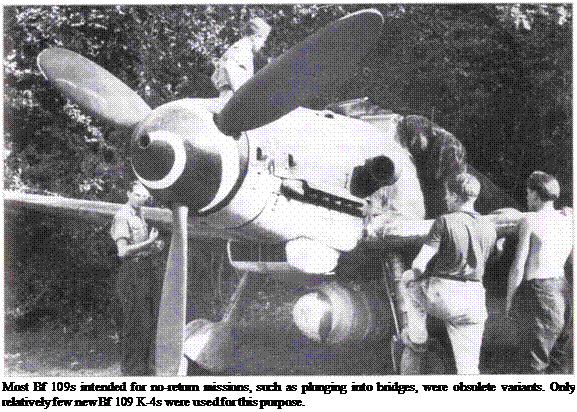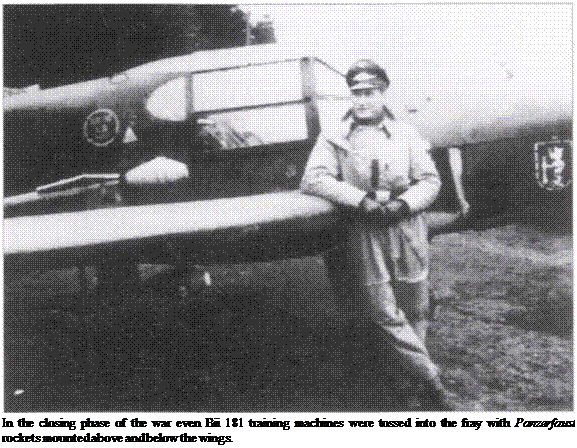Operation Bienenstock

Berlin had been declared a ‘fortress’ on 1 February 1945 and martial law was introduced on 9 April. Anything usable as a weapon was made ready. All available
aircraft were to take part in a low-level attack in the Baruth area. These included 14 pilots who had volunteered for suicide missions. Their motives were various: many had lost family or a partner in the air raids, some wanted to save Germany, others were lost for an explanation.
On 1 April 1945 a number of volunteers in the Berlin Brandenburg area were sent to Magdeburg-Slid and given special identity papers as part of 8. Panzerjagd-Sonderstaffel, a Luftwaffe special anti-tank squadron. Several Вії 181 were prepared on a former Deutsche Lufthansa airfield with construction hangars, on or about 15 April 1945. This low-wing aircraft with dual side-by – side seating was actually a trainer and therefore unarmed. A Hirth HM 500 piston engine provided a speed a little over 200 km/hr or up to 350 km/hr (125/220 mph) in a steep glide. These aircraft would now be used in the antitank role at very low level. In the assembly hangar each wing was fitted with two wooden racks to hold a total of four Panzerfaust rockets. The weapons were fired by tugging on a steel wire leading over or below the wing to the control stick. The rudder was steel plated since in tests with the Panzerfaust it tended to fracture. A simple circular sight mounted on the engine cowling served as a primitive aiming device. At 80 metres range and 100 metres height it was possible to draw a bead on enemy tanks and fire down on them obliquely with some accuracy.
Apart from courage the operation required skill in low-level flying since the Bii 181 was intended to engage tanks with all four rockets during a shallow dive close to the ground. An alternative was an almost horizontal approach followed by a fast turn away. A third tactic involved an approach at less than 50 metres height, rise to 50 metres just short of the target, depress the nose, fire the Panzerfaust rockets and then use whatever ground cover was available to get clear. The aircraft might be hit by anti-aircraft fire at any time between the approach and the escape. Ground troops would also respond with light arms fire if not sheltering from splinter bombs. German losses were disproportional to the number of Soviet tanks destroyed.
Operation Bienenstock was born of despair in the second half of April 1945. This idea was to attack Allied aircraft by Luftwaffe sabotage operations against airfields using explosives or the Panzerfaust. One such squad headed for Weis in a decrepit lorry to find 16 new Fw 190 D-9s with Jumo 213 E-l engines needing maintenance work. Orders came to fly the machines to Halle/Saale with virtually no ammunition. No enemy aircraft were seen and all arrived safely bar Oberleutnant Merkel, who baled out shortly after take-off when his aircraft caught fire. From Halle the 15 survivors reached Wallersdorf airfield. Here the unit commander was advised that his sabotage squad could not be used as ground troops, but shortly afterwards American fighter-bombers attacked the airfield and destroyed their aircraft.

Six selected pilots were sent along the Autobahn to the nearest aerodrome. After surviving an air raid at Rosenheim in the railway station bunker the men got to Salzburg where they found various single and two-seater aircraft drawn up in large numbers on an airfield. They were informed that these light aircraft were to be made operational against the Allies.
On 5 May the men were assembled and received orders to cross the Alps to attack Allied bombers parked on airfields in northern Italy. The following night it snowed and the operation was cancelled. Another special mission was ordered. The men were arranged in small groups. Feldwebel Hans Unmack, who had flown 129 missions, was given a young pilot to assist in navigation to the target. They flew their Fw 44 at tree-top height towards Franconia. Near Nuremberg they easily avoided American anti-aircraft fire by dodging between the bursts – the guns could not adjust to the slow-flying aircraft. When the fuel ran out they landed in pasture in the Steigerwald. After sinking their explosives in a nearby stream they set off on foot for the American lines, and Unmack at least got there.
On 16 April 1945 some of the pilots who had outlived the 7 April suicide mission were ordered to Pocking to be decorated by Oberst Hajo Hermann with the Iron Cross First Class or the German Cross. Further ramming attacks were no longer possible because of the lack of suitable aircraft. There were no useful machines at Pocking. Fifty men now moved off to Neubiberg and then Fiirstenfeldbruck near Munich where they discovered at least four Panzerfaust – armed Bu 181s and other training machines including three new Si 204 D-l night fighter-bombers. A number of flight instructors flew the converted Bii 181 anti-tank aircraft from Trebbin, all but one being shot down by Russian ground fire. In the evening Panzerjagdkommando General Keller was pitched into the fray south of Trebbin. This unit was made up of Aviation Hitler Youth. Next morning they were wiped out. While Goring set off from Berlin for the Alps along the last highway still open from the capital, it was left to flight instructors and pupils with Panzerfausts to hold off a vasdy superior enemy.
On 27 April three sabotage squads left Fiirstenfeldbruck by air for Metz with explosive charges to destroy parked Allied heavy bombers. One of the three machines crashed shortly after take-off. Nothing more was ever heard of the other two Si 204 D-ls. It is possible that the pilots made the right decision for themselves and their passengers. Four Bii 181s were sent to Schwandorf to attack parked American aircraft. Other crews were selected to blow up the bridges over the Danube at Regensburg. Unfortunately it was not known at Fiirstenfeldbruck that engineers had already done the job. All men sent on the missions disappeared. Two Fi 156s with highly decorated pioneer troops aboard crashed when the undercarriage legs broke during landing on swampland near Dillingen behind the American lines. Two men escaped and avoided captivity, at least for the time being.
On 26 April Bienenstock commandos from Fiirstenfeldbruck and Pocking assembled at Zollfeld airfield near Klagenfurt for an operation to attack parked Allied bombers in northern Italy. Forty small aircraft and 80 crew were on hand. In the first mission, involving 20 pilots, only two crews returned to Klagenfurt, and both had a man dead or injured. The target for the attacks had been changed at the last minute from Italy to Hungary. Further desperate flights followed on 5 May to Papa in Hungary and next day to Warasdin. The few surviving machines took off on their final missions on 8 May 1945. Meanwhile Oberst Hermann had been advised of the capitulation by telex. After parading his men for the last time he disbanded the unit. Nearly all crews succeeded in flying, driving or walking to the Allied lines or directly to Germany. In the north, the Hitler Youth remnants of Panzerjagdkommando General Keller retreated before the Red Army towards Schwerin, and from there to Flensburg. Together with General Keller, his staff, some senior NSFK leaders and 150 Fliegerkorps men, they surrendered to the British on the road to North Frisia.










